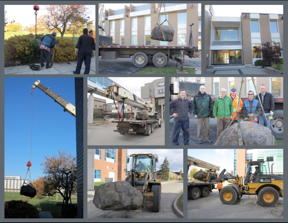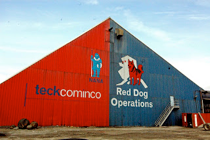Sediment-hosted Zinc-Lead Ore: formed in Paleozoic, Mississippian, 338 million years ago; Red Dog Mine, Northwest Alaska, near Kotzebue
On October 29, 2015, Peter Russell of the University of Waterloo Earth Sciences Museum traveled to Teck Metals’ Product Technology Centre (PTC) in Mississauga to pick up a 3,400 kg rock donated to the Peter Russell Rock Garden on the UW Campus. The rock is zinc-lead ore with silver, from the Red Dog mine in Northwestern Alaska.

Thanks to Paul Kolisnyk and the team at PTC who assisted us with the logistics of moving the rock to Waterloo.
Red Dog Operations is one of the world's largest zinc mines, located about 170 kilometres north of the Arctic Circle in northwest Alaska.
The deposit that became Red Dog mine was first discovered by pilot and prospector Bob Baker in the late 1960s. Baker was flying over the mountains when he noticed a rusty alteration zone in a creek, which was later called Red Dog Creek, after his dog. He alerted the

In 1989, Red Dog Operations was developed through an innovative operating agreement between the operator Teck and the land-owner NANA, a Regional Alaska Native corporation owned by the Iñupiat people of northwest Alaska. Red Dog mine has become a model of responsible resource development, founded on the principles of consensus, cooperation, and mutual respect between a mining company and indigenous people.
Red Dog is an open-pit truck-and-loader operation, using conventional drill and blast mining methods. Since 1989, the mine has undergone several mill optimization projects leading to significant increases in concentrate production.

Red Dog’s production of contained metal in 2016 is expected to be in the range of 545,000 to 570,000 tonnes of zinc and 115,000 to 120,000 tonnes of lead.
The mine life is expected to continue to 2031.
Once the coarse ore is mined from the ground and processed through the flotation mill, all zinc and lead concentrates are transported 84 kilometres via the DeLong Mountain Transportation System haul road to the port facilities on the Chukchi Sea. The specially designed haul truck carries approximately 134 wet metric tonnes (wmt) of concentrate conveyed in two covered side-dump trailers. On average, 26-28 haul truck loads are transported every day, 365 days a year, to meet annual shipping requirements. The concentrate is then stored in the two largest buildings in Alaska, the concentrate storage buildings (CSB). Combined, the CSBs are capable of storing 950,000 wmt of concentrate between shipping seasons.
Because of shallow coastal waters, two lightering barges are employed to convey the concentrate to waiting vessels anchored three nautical miles offshore. Due to the short high arctic summer and extreme weather conditions, the shipping season typically spans a mere 110 days from early July to mid- October, with the bulk of vessel loading occurring within the months of July and August. During this brief window of opportunity, a year’s worth of concentrate must be transported from above the Arctic Circle in the far North to smelters and refineries in North America, Europe, Asia and Australia.